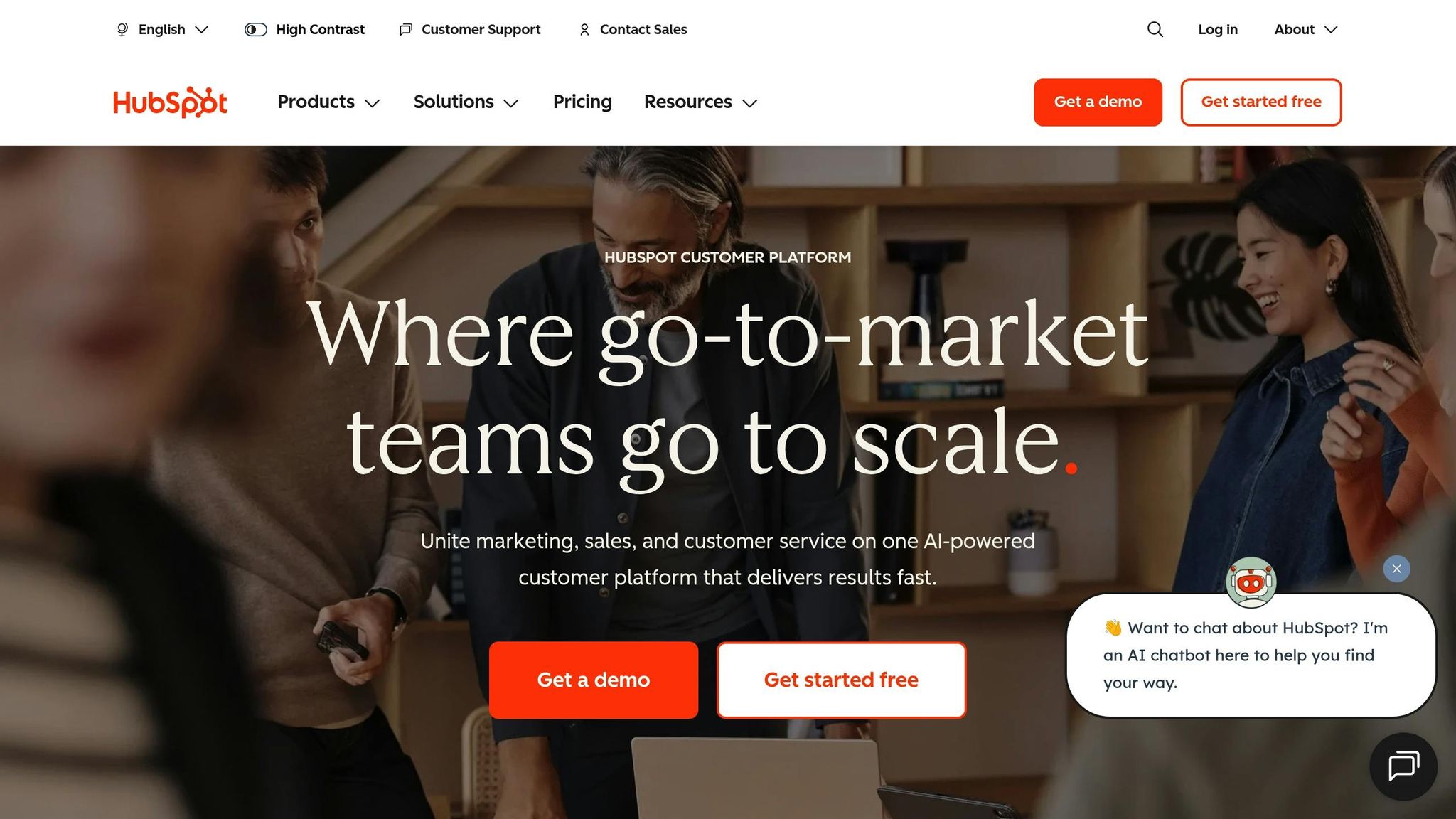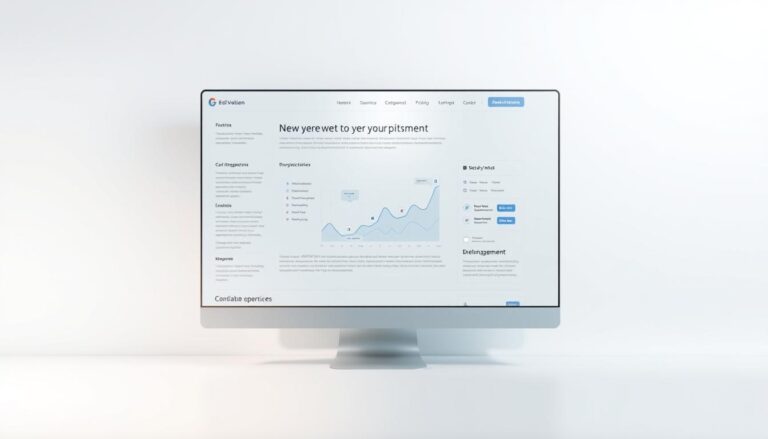Automating lead nurture sequences in your CRM can simplify your sales process while boosting efficiency and revenue. By setting up workflows that handle repetitive tasks like email follow-ups, lead scoring, and segmentation, you can focus on closing deals instead of manual processes. Here’s how to get started:
- Choose the right CRM: Use platforms like Salesforce, HubSpot, or Pipedrive that support automation features like trigger-based workflows, lead scoring, and email personalization.
- Clean and segment your data: Ensure your lead data is accurate and group leads by behavior, industry, or engagement level for targeted messaging.
- Map buyer personas and journey stages: Align your messaging with the unique needs of your audience, from awareness to decision-making.
- Align sales and marketing teams: Define clear handoff points and maintain consistent communication between teams to avoid lead loss.
- Leverage AI tools: Use AI for lead scoring, content personalization, and predicting engagement patterns to improve results.
Tutorial | How to Nurture Leads in HubSpot with Workflows | Hivehouse Digital

Requirements for Setting Up Lead Nurture Automation
Building a strong foundation is critical – any missing piece can lower conversion rates and squander valuable leads. Here’s what you need to set up effective lead nurture automation.
CRM with Automation Features
Your CRM should be equipped to handle complex automation workflows. Platforms like Salesforce, HubSpot, and Pipedrive come with automation engines that can trigger actions based on lead behavior, time delays, and custom conditions.
Key features to look for include:
- Trigger-based workflows that respond to specific lead actions
- Conditional logic for creating dynamic, branching sequences
- Email automation with personalization options
- Lead scoring that updates automatically
- Integration APIs for seamless connection with marketing tools
The automation system should be robust enough to handle multi-step processes. For instance, if a lead downloads a whitepaper, the system should automatically tag the lead, update their score, enroll them in a targeted sequence, and notify the sales team.
If your CRM lacks these capabilities, you’ll quickly run into limitations. Basic CRMs that only allow for simple email sequences won’t cut it for advanced B2B nurturing, which requires multiple touchpoints and personalized messaging.
Clean Lead Data and Segmentation
Accurate and organized data is the backbone of effective automation. Poor data quality undermines even the best workflows. Start by cleaning your database: remove duplicate entries, standardize job titles and company names, and fill in missing fields using data enrichment tools. At a minimum, your lead records should include:
- Company size
- Industry
- Job role
- Engagement history
- Lead source
Segmentation is equally important. Group leads by meaningful characteristics like company size, industry, buying stage, or engagement level. This allows you to tailor your messaging to each group’s specific needs.
For example, enterprise leads will have different concerns than small business owners. A startup founder might prioritize affordability and quick implementation, while an enterprise buyer is more focused on security, compliance, and scalability. Your data structure should support these distinctions to deliver relevant messaging.
Buyer Personas and Journey Stages
To ensure your sequences resonate, map out buyer personas and their journey stages. This step relies on accurate data and effective segmentation.
Document your buyer personas in detail, including their roles, responsibilities, challenges, goals, and decision-making processes. Understand how they research solutions, what content they engage with, and the objections they typically raise.
Next, outline the buyer’s journey stages – from initial awareness to the final decision. Each stage requires tailored messaging. Early-stage leads benefit from educational content that builds trust, while late-stage prospects are looking for product comparisons, case studies, and pricing details.
Marketing and Sales Team Alignment
Alignment between marketing and sales is non-negotiable. Both teams need to agree on lead definitions, handoff processes, and consistent messaging. Without this collaboration, leads may receive conflicting messages and fall through the cracks.
Start by defining Marketing Qualified Leads (MQLs) and Sales Qualified Leads (SQLs). Marketing should know exactly when to pass leads to sales, and sales should understand what nurturing activities the lead has already experienced.
To maintain alignment, create Service Level Agreements (SLAs) between the teams and hold regular meetings to review performance and refine handoff processes.
Consistency in messaging is vital. Document your value propositions, key messages, and positioning statements to ensure both teams communicate cohesively across all touchpoints.
How to Set Up Automated Lead Nurture Sequences in CRM
Once you’ve laid the groundwork, it’s time to create lead nurture sequences that deliver the right message at just the right time. By automating these follow-ups, you can turn a manual, time-consuming process into a streamlined system that works efficiently in the background. This step builds on your CRM setup and data quality to ensure smooth automation throughout your lead nurturing efforts.
Segment Leads by Key Criteria
Effective lead nurturing starts with smart segmentation. By grouping leads based on specific criteria, you can ensure your messages are always relevant and timely. Dynamic segmentation is especially useful, as it updates automatically when a lead’s attributes or behaviors change.
- Behavioral segmentation: Focus on what actions leads are taking – like downloading a whitepaper, attending a webinar, or visiting your pricing page. These behaviors give you clues about their interests, so you can tailor your content accordingly.
- Firmographic segmentation: Group leads based on company details. For example, enterprise prospects often have longer sales cycles and require input from multiple stakeholders, while smaller businesses might make decisions faster but be more price-sensitive.
- Engagement-based segmentation: Look at how actively leads are interacting with your content. High-engagement leads might benefit from frequent touchpoints, while low-engagement leads may need re-engagement campaigns with fresh formats.
Set up your CRM to automatically adjust these segments as leads’ behaviors or profiles evolve. For instance, if a lead shows increased interest or their company size changes, they should be moved into the appropriate nurture track without manual intervention.
Set Up Triggers and Actions for Nurture Workflows
To make your nurture sequences work seamlessly, you’ll need to establish triggers and actions that guide leads through the process. These triggers ensure your messages are timely and relevant.
- Form submission triggers: Capture details like the type of content downloaded or the lead source. For example, a lead who downloads a case study from a paid campaign might enter a different workflow than someone who discovered the same resource organically.
- Email and website behavior triggers: Track engagement patterns such as time spent on key pages, specific page visits, or return visits. These behaviors often signal buying intent and can guide your next steps.
- Time-based triggers: Keep your follow-ups consistent. For instance, if a lead hasn’t engaged within 30 days, you might trigger a re-engagement campaign. If they remain unconverted after 90 days, it could be time to alert your sales team.
Your actions should feel personalized and helpful. Suggest resources that are relevant to the lead’s industry or role, ensuring your messaging feels tailored rather than generic.
Add Conditional Logic and Branching
Static workflows are a thing of the past. Conditional logic and branching allow your nurture sequences to adapt dynamically based on a lead’s behavior or profile, creating a more personalized experience.
For instance:
- High-intent leads can transition to sales-focused content, while others might stay on educational tracks with longer intervals.
- Industry-specific branching ensures leads receive content relevant to their field. A healthcare lead might get information on HIPAA compliance, while a retail lead gets insights tailored to their challenges.
- Role-based logic addresses unique decision-maker concerns. A technical lead might need integration details, while a business executive might respond better to ROI-focused messaging.
"Clay enables our team to rapidly experiment with trigger-driven workflows and third-party enrichment data. We’re able to move fast and drive outsized impact on GTM execution – all while using a tool that’s fun, creative, and cutting edge." – Scotty Huhn, Revenue Strategy & Data, OpenAI
For leads with incomplete data, set up default paths. For example, if a lead’s industry isn’t specified, guide them through a general sequence that addresses common challenges while gathering more details along the way.
Use AI and Automation Tools
With your workflows in place, AI tools can take your automation to the next level. These technologies can optimize processes, personalize content, and even predict lead behavior with greater precision.
- AI-driven lead scoring: Continuously refine lead quality by analyzing engagement, demographics, and behavior patterns. This ensures your sales team focuses on the best opportunities.
- Dynamic content personalization: Tailor emails to each lead’s unique profile. Automated testing of different messaging approaches can also improve engagement.
- Predictive send-time optimization: Analyze when individual leads are most likely to engage and adjust delivery times to maximize impact.
Automation platforms also enable advanced workflows that go beyond standard CRM capabilities. They can enrich data, handle complex multi-step processes, and streamline even the most intricate tasks.
"Clay is a game changer for marketing, data, and operations. We have tripled our enrichment rate with Clay’s combination of data providers vs. our previous solution. We’re using the best aggregate results across a waterfall of data sources and implementing complex workflow logic – even beyond enrichment. Of course, it’s all powered by AI. Clay makes it easy to use AI for GTM initiatives, unlocking new workflows that were infeasible before." – Adam Wall, Head of Sales Operations, Anthropic
For businesses with unique needs, custom-coded solutions can fill the gaps. SixtySixTen specializes in building tailored automation systems that work seamlessly with your CRM, combining no-code tools and custom development to fit your processes perfectly.
Test, Launch, and Monitor Nurture Sequences
Before going live, thoroughly test your workflows to ensure everything runs smoothly. Use leads with varied attributes to identify potential issues, and verify that emails render correctly across all devices and email clients.
Incorporate A/B testing from the beginning. Experiment with subject lines, send times, content formats, and call-to-action placements on smaller segments. Once you identify what works, scale those successful elements to the broader audience.
Test your workflow logic to ensure leads with specific attributes are routed correctly and triggers activate as intended. Don’t forget to account for edge cases, like leads with incomplete information or those meeting multiple criteria.
As your sequences run, monitor key metrics such as open rates, click-through rates, conversion rates, and unsubscribe rates. Track the overall impact by measuring metrics like marketing-qualified leads generated, average conversion time, and revenue attribution.
Set up alerts for unusual patterns, such as a sudden drop in open rates or a spike in unsubscribes. Real-time dashboards can help you spot bottlenecks, track lead progression, and continuously refine your automation strategies.
sbb-itb-647c22e
How to Customize and Optimize Lead Nurture Sequences
Once your automated sequences are up and running, the real challenge begins: turning basic workflows into highly effective systems that cater to each lead’s specific profile and behavior. The goal is to go beyond generic messages and create tailored experiences that resonate with your prospects.
Personalize Content Based on Lead Attributes
Personalization means crafting content that speaks directly to a lead’s unique profile. To do this well, you need rich, detailed data. Pull from multiple sources to build complete profiles that include everything from company details to behavioral patterns and even technology usage. This enriched data forms the backbone of outreach that addresses specific challenges and opportunities.
AI-powered lead scoring takes this a step further by analyzing engagement patterns, demographic information, and behavioral signals in real time. Unlike static scoring models, these systems evolve as they learn what drives conversions in your market. When a lead’s score shifts, your nurture sequences can automatically adjust to match their level of interest, offering the right content at the right time.
Using conditional logic, you can create customized paths based on lead attributes. For instance, you might tailor messaging to meet industry-specific needs or align with customer preferences. This ensures every lead gets communication that feels relevant and personalized.
AI agents can also play a key role by drawing on data from your CRM, call recordings, and internal documents to maintain consistent messaging across workflows. These agents adapt based on what has worked with similar prospects, helping you scale personalization without losing quality.
You can also create dynamic audiences by combining intent signals, enrichment data, and CRM records. Leads showing high intent can automatically be moved into faster-paced nurture tracks, ensuring they get the attention they need when they’re most engaged.
Once personalized content is in place, the next step is to measure how well these workflows are performing and refine them accordingly.
Use Performance Metrics to Improve Workflows
Personalized content is just the beginning. To truly optimize your lead nurture sequences, you need to track performance metrics that show where your workflows are succeeding and where they need improvement. These metrics provide a clear picture of how leads are moving through your funnel and help you pinpoint areas for adjustment.
Start with engagement metrics like open rates and click-through rates. These give you immediate feedback on whether your content is hitting the mark. If open rates drop after a few emails, it might signal that your content isn’t building enough value or that you’re sending messages too frequently.
Conversion tracking is another key metric. By monitoring email responses alongside website activity, you can identify which messages and content types are driving the most qualified leads. This helps you refine your approach to focus on what works.
Time-to-conversion analysis can reveal the optimal pacing for your sequences. If leads are taking too long to convert, you might need to adjust your timing or consider moving them to direct sales outreach sooner.
Segment performance tracking is also valuable. By analyzing how different lead types respond to your sequences, you can refine your segmentation strategy and create even more targeted content.
Finally, attribution analysis ties nurture sequence engagement directly to revenue. This not only helps you allocate resources more effectively but also demonstrates the impact of your nurture programs on the bottom line.
Build Real-Time Dashboards for Performance Tracking
Once you’ve refined your workflows using performance metrics, real-time dashboards can help you monitor and optimize your nurture sequences on an ongoing basis. These dashboards provide a clear view of campaign performance, turning raw data into actionable insights.
Tools like Google Looker and PowerBI are great for visualizing data from your CRM, email platforms, and marketing automation tools. They can give you both high-level summaries and detailed breakdowns for specific campaigns or segments.
For example, lead progression tracking can show how prospects are moving through your sequences, while performance comparison views let you analyze multiple campaigns side by side to identify best practices. Alerts can also be set up to notify you when key metrics deviate from expected ranges, allowing you to act quickly.
If your business has complex nurture programs that span multiple products or market segments, custom dashboards might be the way to go. Companies like SixtySixTen specialize in building tailored solutions that integrate tools like Google Looker and PowerBI with custom development, ensuring you get the insights you need in real time.
Some dashboards even include predictive analytics features, which can identify leads most likely to convert or churn. This allows you to adjust your nurture strategies proactively, based on future trends rather than past performance.
Key Takeaways
Automating lead nurture sequences within your CRM can turn manual follow-ups into efficient, scalable workflows. The key to success lies in creating systems that rely on clean data management, AI-driven personalization, and real-time adjustments. These elements work together to streamline your CRM processes and drive revenue growth.
To get started, choose a CRM that offers strong automation capabilities, supports clean and segmented data, and aligns seamlessly with both sales and marketing teams. Incorporate behavior-based triggers, conditional logic, and AI-powered tools for lead scoring and personalized content delivery.
Track performance metrics to optimize your workflows. Build real-time dashboards to measure campaign results and use AI-powered lead scoring that adapts to market changes. By analyzing data from segmentation and trigger performance, you can fine-tune your strategies for better outcomes.
For example, SixtySixTen helps go-to-market teams increase revenue by 30% and improve efficiency by 2.5x. They achieve this by integrating no-code platforms like Make.com and Clay.com with custom-coded solutions when off-the-shelf tools don’t meet specific needs.
Automated nurture sequences not only improve conversion rates but also reduce manual workloads. They allow you to scale personalized outreach without needing to grow your team proportionally, turning your CRM into a powerful tool for driving consistent revenue.
FAQs
What are the main advantages of using AI tools to automate lead nurturing in a CRM?
AI tools offer game-changing benefits when it comes to automating lead nurturing within a CRM. They make personalization and targeting more effective by handling real-time lead scoring, segmenting audiences, and enriching data. This ensures every lead gets communication that’s tailored to their specific needs.
On top of that, AI streamlines workflows by taking over repetitive tasks like updating the CRM, scheduling follow-ups, and managing outreach. This frees up sales teams to concentrate on what they do best – building relationships and closing deals – leading to greater efficiency and quicker outcomes.
How can I keep my lead data accurate and organized for better automation and segmentation?
Maintaining well-organized and accurate lead data is essential for effective automation and precise segmentation. Start by incorporating AI-powered tools that can handle tasks like real-time lead scoring, data enrichment, and segmentation. This keeps your data current and ensures it’s ready for action.
It’s equally important to regularly clean and standardize your data. This involves removing duplicates, fixing inconsistencies, and ensuring everything follows a uniform format. By integrating your CRM with other tools, you can automate much of this process, allowing enriched data to sync across your systems effortlessly.
To take it a step further, explore customized automation solutions. These can help eliminate repetitive manual tasks and streamline your workflows, making lead management smoother and more scalable.
How can I align my sales and marketing teams to automate lead nurturing effectively?
To make lead nurturing more efficient, start by ensuring your sales and marketing teams are on the same page. Align their goals – whether it’s boosting lead quality or driving more conversions – and set up clear communication channels to keep everyone informed and working together.
Use automation tools to handle repetitive tasks like qualifying leads, sending follow-up messages, and updating your CRM. This frees up your team to focus on what matters most: building relationships and closing deals. Take it a step further with AI-powered tools for lead scoring and segmentation, which can help you tailor your outreach and target the right prospects. Automating tasks like scheduling demos and managing pipeline transitions can also speed up workflows and make your entire process more efficient.



